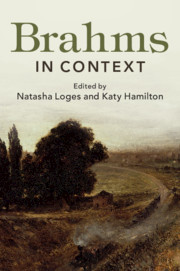Book contents
- Brahms in Context
- Brahms in Context
- Copyright page
- Dedication
- Contents
- Illustrations
- Music Examples
- Notes on Contributors
- Preface
- Abbreviations
- Part I Personality, People and Places
- Part II Identities, Environments and Influences
- Part III Performance and Publishing
- Part IV Society and Culture
- Part V Reception and Legacy
- Further Reading
- Index
- References
Part III - Performance and Publishing
Published online by Cambridge University Press: 15 May 2019
- Brahms in Context
- Brahms in Context
- Copyright page
- Dedication
- Contents
- Illustrations
- Music Examples
- Notes on Contributors
- Preface
- Abbreviations
- Part I Personality, People and Places
- Part II Identities, Environments and Influences
- Part III Performance and Publishing
- Part IV Society and Culture
- Part V Reception and Legacy
- Further Reading
- Index
- References
Summary
Throughout his lifetime, Brahms accompanied dozens of singers in a variety of settings, ranging from huge public halls to his friends’ homes, and conducted many others in choirs. Some of those working relationships were one-offs, arising from the widespread practice of including a set of piano-accompanied songs within most concerts and the expediency and cost-effectiveness of using local talent. Others were deep, enduring partnerships; the timbres and interpretative approaches of those singers are surely ingrained in his vocal music. Overall, Brahms’s singers were generally not part of the international operatic elite associated with Verdi, Bizet and Massenet. Figures like Julius Stockhausen (1826–1906) and Raimund von Zur-Mühlen (1854–1931)were almost exclusively concert singers and, later on, teachers. Most hailed from German-speaking territories, reflecting Brahms’s own concert career.
Keywords
- Type
- Chapter
- Information
- Brahms in Context , pp. 185 - 256Publisher: Cambridge University PressPrint publication year: 2019



